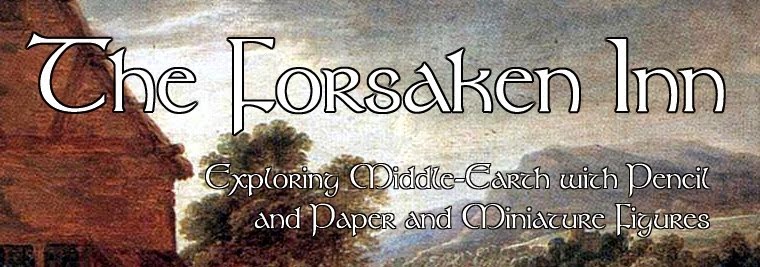We take a journey into the realm of the elves with
Battle
Games in Middle-earth #8, temporarily forsaking the world of Men, Hobbits, and
Orcs for an older race. Fans of Legolas Greenleaf undoubtedly rejoiced when
this issue hit the stands, as it not only provides rules for including the
elven archer in your tabletop battles, but a lovely metal miniature of him as
well.
This issue’s “Guide to Middle-earth” covers more ground than
normal. First off, the chapter examines the various weapons one might wield or
face in battle. Uruk-hai crossbows, bladed orc bows, elf bows, throwing axes, two-handed
weapons such as elf swords and dwarven axes, and general hand weapons all are
briefly described accompanied by movie production photos.
The second section of the chapter gives us a thumbnail look
at Lothlorien, Land of the Elves. This provides background information for the
scenario appearing later in the issue, as well as presenting an extremely brief
overview of Lothlorien’s place in Middle-earth and its mistress, Galadriel.
The third section introduces the reader to Legolas, Woodland
Prince. It covers his role in the Fellowship, his skills and natural talents,
and describes his “battle highlights” of memorable moments in the conflicts the
Fellowship endured, up to and including Helm’s Deep.
After this lengthy “Guide,” issue #8 dives into the “Playing
the Game” section. This issue’s chapter isn’t an in-depth one as others have
been. I suspect the increased page count of the preceding section cut into the
available space for #8’s “Playing the Game.” We received a mere two pages that
broadly describe SBG’s missile weapons. Basic rules for thrown weapons, previously
undiscussed, are the most useful piece of information from the two pages,
although the crossbow is also introduced. Alas, while it’s stated that an
Uruk-hai armed with a crossbow cannot move if it wishes to fire during the
Shoot phase, no range or Strength rating is given for the weapon, making the
new weapon yet unusable in your combats.
The “Battle Game” chapter is “Raid on Lothlorien,” a
scenario which takes place shortly after the Fellowship flees Moria. The
premise is that the goblins of Moria emerge after nightfall to hunt them down.
The horde of goblins clashes with Haldir and his elves, sending some of the
forces of Evil scrambling back towards Moria. Simultaneously, Frodo has become
separated from the Fellowship and Legolas catches up with him just as a band of
goblin hunters—led by a Moria Goblin Captain—stumbles upon them. Making matters
worse, goblins fleeing Haldir and his guards come upon the scene from the
opposite side of the board, effectively catching Frodo and Legolas between the
hammer and anvil. Can the Ringbearer and the Woodland Prince escape?
“Painting Workshop” provides the usual step-by-step method
of turning this issue’s model into a tabletop ready combatant. Legolas
Greenleaf comes to life as the tutorial explains how to use a black lining
technique to create more realistic looking clothing and faces, instructions sure
to be useful as we increase our collection of models. Also helpful is a tip
about using tile as a mixing palette. Cheap and re-usable, it’s a great new
addition to our inventory of painting tools.
Our last section, my beloved “Modelling Workshop” covers how
to scratch-build trees for your table. Trees are a miniature wargaming staple,
and no board is complete without at least a few of these to breakup lines of
sight, provide cover, and offer dense terrain to negotiate. The instructions
provided demonstrate how to make cheap but presentable trees for your table.
The results, at least on paper, look good. We’ll see how they stack up when we
sit down to craft our own.
Issue #8’s final page offers up a preview of what Battle
Games in Middle-earth #9 has in store for us. It looks like bad news for Rohan
next time as we get a scenario pitting Uruk-hai against a Rohan village, a metal
Uruk-hai Captain model to paint and to lead them, as well as new rules for
weapons including pikes, two-handed swords, and others. Luckily, it seems like
instructions for building a Rohan warning beacon are also provided, giving us
hope of calling for aid.
Until then, let’s dive deeper in Battle Games in
Middle-earth issue #8!























